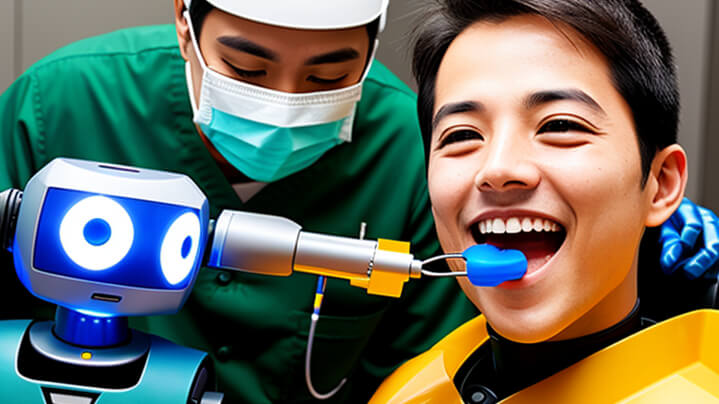
Digital Dentistry Technology Advancements
The Digital Dentist – Technology Advances in Dentistry
Contents
As a dental patient, it is exciting to think about the future of digital dentistry and the advancements that are being made in this field. Digital dentistry is transforming the way dentists diagnose and treat patients, and it is revolutionizing the way dental care is delivered. With digital dentistry, dentists can use 3D imaging and computer-aided design (CAD) to create customized dental prosthetics, such as crowns, bridges, and veneers. This technology also allows dentists to create digital models of the patient’s mouth and teeth, which can be used to plan treatments and monitor progress.
What is Digital Dentistry?
Digital dentistry refers to the use of digital technologies and techniques in dentistry. This includes using tools and systems such as digital imaging, computer-aided design (CAD), computer-aided manufacturing (CAM), intraoral scanners, 3D printing, and other technologies to help dentists design and produce dental restorations and prostheses more efficiently and accurately.
Advantages of Digital Dental Technology
There are several advantages of digital dental technology for patients, including:
- Improved accuracy: Digital technology provides greater accuracy and precision in designing and producing dental restorations, resulting in better fitting and longer-lasting prostheses.
- Reduced chair time: With digital technology, designing and producing dental restorations can be completed in a single visit, reducing the number of visits required and minimizing chair time.
- Increased patient involvement: Patients can be more involved in the design process, giving them greater control over the final product.
- Improved comfort: Digital technology often requires less invasive procedures, such as digital impressions, which can be more comfortable for patients.
- Better communication: Digital technology allows for improved communication between dentists and dental labs, resulting in better coordination and faster turnaround times for dental restorations.
- Greater predictability: Digital technology can help predict outcomes and improve treatment planning, resulting in better outcomes and more predictable results.
Digital dentistry can improve the accuracy and speed of dental procedures, reduce the need for physical impressions, and offer more customized and precise dental restorations. It can also help dentists to communicate more effectively with patients by using digital images and simulations to show them what their teeth will look like after treatment. Digital dentistry is an area of growing interested and investment in the dental industry.
Let’s explore some uses of digital technology in dentistry.
Imaging and Scanning Technologies
These technologies provide detailed images of your teeth and mouth, allowing your dentist to diagnose and treat any issues more accurately. The images are incredibly accurate and can be used to plan complex treatments such as dental implants. Digital imaging and scanning technologies provide your dentist with the information they need to diagnose and treat any issues you may have accurately.
Intraoral Scanners
Intraoral scanners are a revolutionary technology that has revolutionized the dental industry. These scanners capture digital images of the inside of a patient’s mouth, allowing dentists to diagnose and treat dental problems accurately. The scanners use a combination of optical imaging and computer-aided design (CAD) to create detailed 3D images of the teeth and gums.
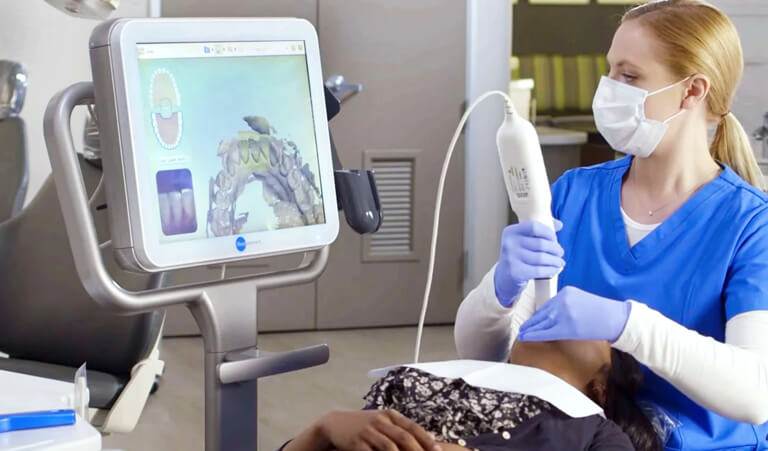
The images can then be used to create accurate models of the patient’s mouth, which can be used to create customized dental treatments. Intraoral scanners are highly accurate and can provide dentists with a much more detailed view of the patient’s mouth than traditional X-rays. This allows dentists to diagnose and treat problems more quickly and accurately, leading to better patient outcomes. Additionally, intraoral scanners are much less invasive than traditional X-rays, making them a more comfortable patient experience. Intraoral scanners are an invaluable tool for dentists, quickly becoming the standard of care in the dental industry.
There are several manufacturers of intraoral scanners, including:
- 3Shape: A Danish company that produces a wide range of dental products, including intraoral scanners, CAD/CAM software, and 3D printers.
- Align Technology: The company that makes Invisalign clear aligners also produces the iTero intraoral scanner.
- Carestream Dental: A company that produces a range of dental imaging and CAD/CAM solutions, including the CS 3600 intraoral scanner.
- Dentsply Sirona: A global leader in dental technology, Dentsply Sirona produces the CEREC intraoral scanner and a range of other dental products.
- Planmeca: A Finnish company that produces a range of dental equipment and software, including the Planmeca Emerald intraoral scanner.
- Medit: A South Korean company that produces the i500 intraoral scanner.
- GC Corporation: A Japanese company that produces the Aadva IOS intraoral scanner.
- 3DISC: A US-based company that produces the Heron IOS intraoral scanner.
- Shining 3D: A Chinese company that produces the Aoralscan intraoral scanner.
Digital X-rays
Digital X-ray imaging uses digital sensors to capture and store images of a patient’s teeth, enabling dentists to view and manipulate the images on a computer screen.
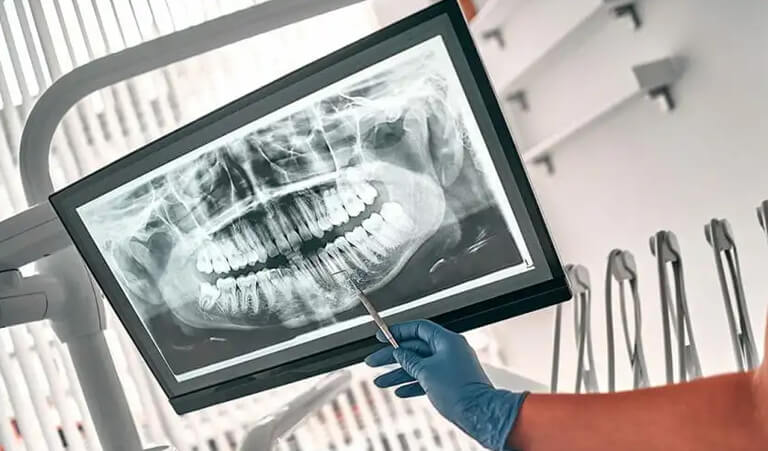
Intraoral scanners capture digital images of the inside of a patient’s mouth, which can be used to create 3D models for various dental procedures. Digital X-rays, on the other hand, use low radiation levels to create images of a patient’s teeth and jaws, which can diagnose dental problems, monitor oral health, and plan treatments. While both technologies are digital and can improve the accuracy and efficiency of dental procedures, they serve different purposes and use different types of equipment.
Cone Beam Computed Tomography (CBCT)
Cone Beam Computed Tomography (CBCT). CBCT is an imaging technology that creates 3D images of the teeth, jaws, and other facial areas. This technology is used to diagnose and plan treatment for dental conditions, including impacted teeth, temporomandibular joint (TMJ) disorders, and sinus conditions. It is also used to assess the need for dental implants and evaluate the jaw and teeth anatomy before surgery.
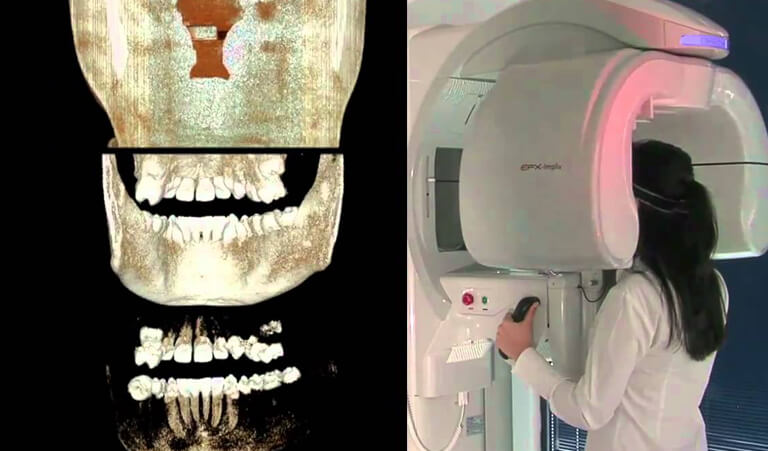
CBCT is a fast and safe imaging technique that produces high-resolution images with less radiation than traditional X-rays. The images can also be used to monitor the progress of treatment and to assess the need for further treatment.
CBCT is a safe and fast imaging technique that produces high-resolution images with less radiation than traditional X-rays. If you’re a dental patient, you may ask your dentist if CBCT is an appropriate imaging technique for your condition.
Computer-Aided Design and Manufacturing (CAD/CAM) technologies
Computer-aided design (CAD) and computer-aided manufacturing (CAM) technologies are computer-based systems that allow dentists to design and manufacture custom dental restorations more accurately and efficiently than ever before. With CAD/CAM, dentists can create a digital model of your teeth and gums, which is then used to design a custom restoration suited to your mouth. This means you can get a restoration that fits perfectly and looks natural. Additionally, CAD/CAM technologies allow dentists to fabricate restorations in-house, eliminating the need to send them out to a lab.
This can save you time and money, as you won’t have to wait for the restoration to be shipped back from the lab. In addition, CAD/CAM technologies can be used to create digital impressions of your teeth, which can be used to create a more accurate and comfortable fit for crowns, bridges, and other dental restorations. With CAD/CAM, you can be sure that you’re getting the best possible restoration for your mouth.
CAD/CAM Systems
CAD/CAM dentistry is revolutionizing the way dentists practice. Using computer-aided design and computer-aided manufacturing (CAD/CAM) technology, dentists can create dental restorations such as crowns, bridges, and veneers with greater accuracy and precision than ever before.
Some examples of CAD/CAM dentistry include:
- In-office ceramic restorations: This involves creating ceramic restorations (inlays, onlays, crowns, or veneers) using a CAD/CAM system right in the dental office.
- Chairside milling: This is a type of CAD/CAM dentistry that allows the dentist to design and mill dental restorations, such as crowns, inlays, and onlays, in a single visit.
- Implant planning: CAD/CAM technology can create a virtual 3D model of a patient’s mouth and plan implant placement and restoration before the surgery.
- Orthodontic treatment planning: CAD/CAM can also be used to plan orthodontic treatment, such as Invisalign, by creating a digital model of the patient’s teeth and simulating the movement of teeth.
- Digital smile design involves using CAD/CAM technology to create a digital mock-up of a patient’s ideal smile, which can be used as a guide for restorative and cosmetic dental treatments.
This technology allows dentists to create highly customized restorations tailored to patients’ needs. CAD/CAM dentistry also eliminates the need for messy impressions, which can be uncomfortable for some patients.
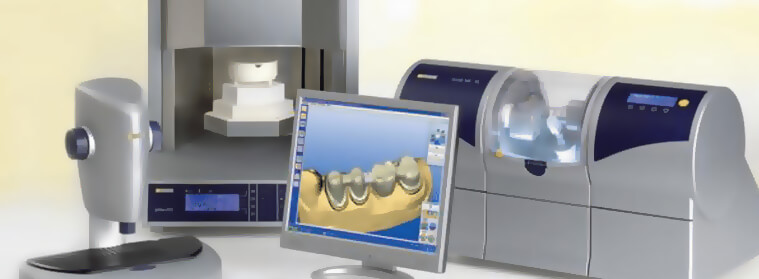
Restorations created with CAD/CAM technology are stronger and more durable than those created with traditional methods. Patients can expect their restorations to last longer and require fewer repairs. CAD/CAM dentistry is also faster than traditional methods, allowing dentists to complete procedures in a fraction of the time. These benefits make CAD/CAM dentistry an attractive option for dentists and patients.
There are several manufacturers in the CAD/CAM dentistry industry. Here are a few examples:
- Dentsply Sirona: Dentsply Sirona is one of the largest manufacturers of CAD/CAM dental equipment, including milling machines, scanners, and software.
- Ivoclar Vivadent: Ivoclar Vivadent is a leading dental materials and equipment manufacturer, including CAD/CAM systems for milling restorations.
- Planmeca: Planmeca offers a range of dental equipment, including CAD/CAM systems, 3D scanners, and milling machines.
- 3Shape: 3Shape is a Danish company that produces 3D scanners and software for CAD/CAM dental applications.
- Roland DGA: Roland DGA is a manufacturer of dental milling machines and 3D scanners.
- Amann Girrbach: Amann Girrbach produces CAD/CAM systems, milling machines, and 3D scanners for dental restorations.
- Straumann: Straumann is a Swiss company that produces dental implants, CAD/CAM equipment, and software for restorative dentistry.
- KaVo: KaVo produces a range of dental equipment, including CAD/CAM systems, 3D scanners, and milling machines.
- Zirkonzahn: Zirkonzahn is an Italian company specializing in CAD/CAM systems for dental applications, including milling machines and 3D scanners.
Digital Impression Systems
Digital impression systems use 3D scanning technology to create a digital impression of your teeth, eliminating the need for messy, uncomfortable putty impressions. This technology is fast, accurate, and can even create crowns and bridges in a single visit. With digital impression systems, you can quickly get dental work with much less discomfort.
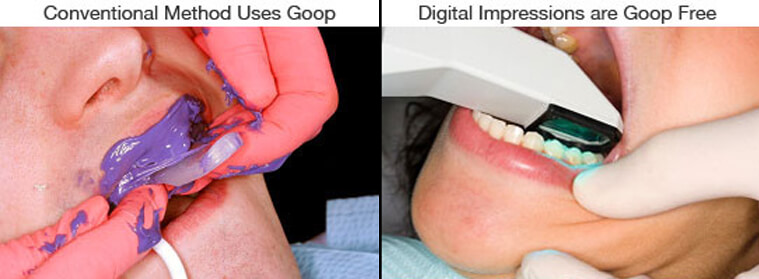
Digital Impression Systems use digital scanners to capture a 3D image of the teeth and soft tissues in the mouth, while the conventional method using goop involves taking an impression of the teeth using a putty-like substance. There are several advantages to using digital impression systems over the conventional method, including the following:
- Accuracy: Digital scanners provide more accurate impressions of the teeth and soft tissues in the mouth, reducing the need for multiple impressions and remakes.
- Efficiency: Digital scanners are faster and more efficient than the conventional method, reducing patients’ time in the dental chair.
- Comfort: Digital scanners eliminate the need for patients to endure the discomfort of having a putty-like substance in their mouth for an extended period.
- Environmentally friendly: Digital impression systems eliminate the need for the materials used in conventional impressions, which can be harmful to the environment.
- Improved patient communication: Digital impression systems allow dentists to show patients a 3D image of their teeth and soft tissues, helping to improve patient communication and understanding of their treatment plan.
Overall, digital impression systems are a more efficient, accurate, and comfortable alternative to the conventional method of taking dental impressions. Several companies manufacture digital impression systems, including:
- 3Shape
- Align Technology (makers of the iTero scanner)
- Dentsply Sirona
- Planmeca
- Carestream Dental (makers of the CS 3600 scanner)
- Medit (makers of the i500 scanner)
- GC America Inc. (makers of the Aadva IOS scanner)
- KaVo Kerr (makers of the KaVo™ X Pro intraoral scanner)
3D printing in Dentistry
3D printing has revolutionized the dental industry, providing dentists with an efficient and cost-effective way to create dental prosthetics. This technology has enabled dentists to create highly accurate dental prosthetics such as crowns, bridges, dentures, and implants. 3D printing allows dentists to create custom prosthetics tailored to patients’ needs. This technology has allowed dentists to provide patients with more comfortable and natural-looking prosthetics than ever before.
There are several applications of 3D printing in dentistry, including:
- Orthodontics: 3D printing produces clear aligners, retainers, and other orthodontic devices.
- Prosthodontics: 3D printing produces dental prostheses like crowns, bridges, and dentures.
- Implantology: 3D printing produces surgical guides for dental implant placement.
- Endodontics: 3D printing is used to produce custom endodontic instruments and models.
- Maxillofacial surgery: 3D printing produces custom surgical models and guides for craniofacial surgery.
- Education and training: 3D printing produces dental education and training models, including models of teeth, jaws, and other oral structures.
- Digital smile design: 3D printing produces physical models of proposed cosmetic dental restorations to aid patient communication and treatment planning.
3D printing has drastically reduced the time and cost associated with the production of dental prosthetics. By eliminating the need for manual labor and costly materials, 3D printing has enabled dentists to provide their patients with high-quality prosthetics at a fraction of the cost. 3D printing has also enabled dentists to provide their patients with more durable and long-lasting prosthetics than ever before. This technology has allowed dentists to create prosthetics resistant to wear and tear, ensuring they last for many years. With the help of 3D printing, dentists can now provide their patients with comfortable and durable prosthetics.
Computer-Guided Surgery and Treatment Planning
Are you considering a dental procedure but worried about the risks? Computer-guided surgery and treatment planning can help make your dental procedure safer and more precise. This technology uses 3D imaging and computer-aided design to plan the exact steps of a dental procedure. It can help your dentist or oral surgeon determine the best approach for your needs. Computer-guided surgery and treatment planning can also help reduce the risk of complications during the procedure. Using 3D imaging, your dentist can get a more accurate picture of your teeth and gums and plan the procedure accordingly. This can help reduce the chances of any unexpected issues during the procedure.
Computer-Guided Implant Surgery
Dentists can use CBCT and computer-aided design (CAD) software to plan and execute dental implant placement with high accuracy and precision.
Are you considering getting dental implants? If so, you may be interested in learning about computer-guided implant surgery. This cutting-edge technology has revolutionized the dental implant process, making it faster, safer, and more accurate than ever. With computer-guided implant surgery, your dentist can use 3D imaging to plan the exact placement of your implant so that it is placed in the ideal spot for optimal results.
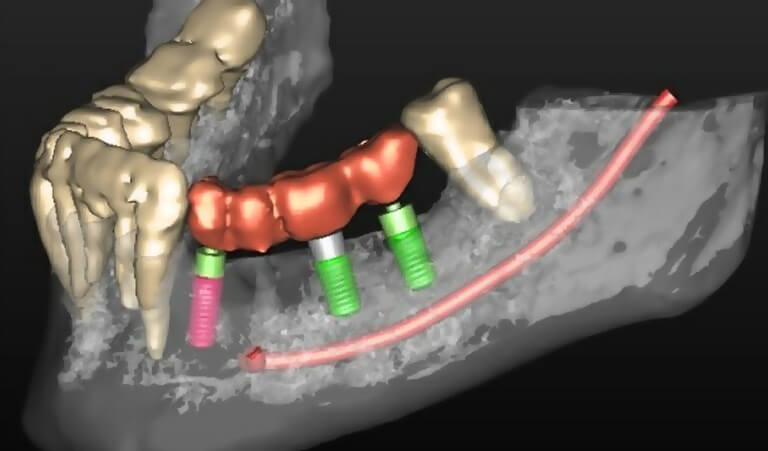
3D imaging lets your dentist see where the implant should be placed about the surrounding bone and other structures. This helps to ensure that the implant is placed in the most secure and stable position. During the procedure, your dentist will use a computer-guided drill to place the implant in the exact location planned precisely. This eliminates the need for guesswork and ensures that the implant is placed in the most secure position.
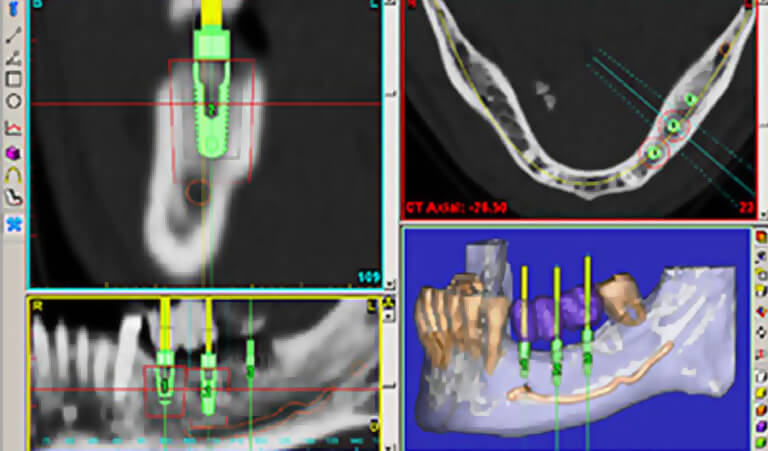
Computer-guided implant surgery also reduces the risk of complications, such as infection and nerve damage, as the procedure is much more precise than traditional methods. In addition, the entire process is much faster, allowing you to get your new implant in less time. Computer-guided implant surgery may be the right choice if you’re looking for a safe and efficient way to get dental implants.
Virtual Smile Design
With specialized software, dentists can create a digital model of a patient’s teeth and gums and then use that model to design and preview cosmetic dental procedures such as veneers, crowns, and bridges.
With Virtual Smile Design, you can get the smile of your dreams without ever having to leave your home! Virtual Smile Design is a revolutionary way to get the perfect smile without ever stepping foot in a dental office. It allows you to design your smile with the help of a professional dental team.
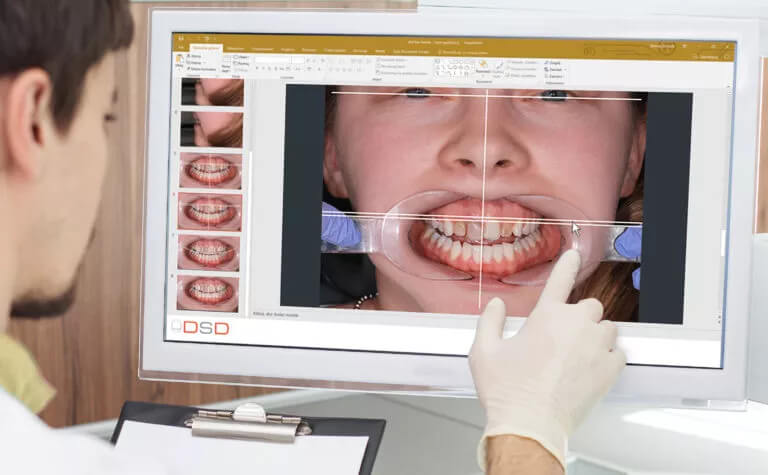
The process begins with a 3D scan of your mouth, which is then used to create a digital model of your teeth. From there, you can customize your smile with various options, such as the shape, size, and color of your teeth. To boost your smile, you can add other features, such as veneers or whitening. Once you’ve designed your perfect smile, the dental team will create a plan to make it a reality. With Virtual Smile Design, you can get the smile you’ve always wanted without ever having to leave the comfort of your own home.
Computer-Aided Orthodontics
Computer-aided orthodontics is a revolutionary technology that has revolutionized how orthodontists diagnose and treat patients. This technology uses 3D imaging to create a digital model of the patient’s teeth, allowing the orthodontist to create a personalized treatment plan tailored to the patient’s needs.
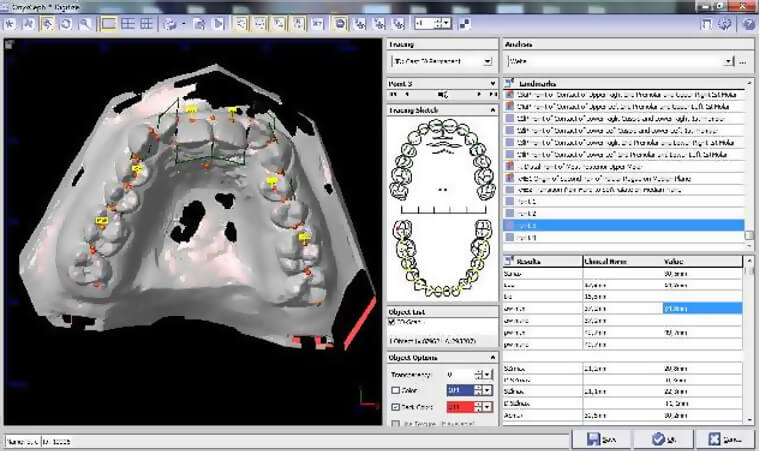
This technology also allows the orthodontist to monitor the progress of the treatment more accurately, making adjustments as needed to ensure the best possible outcome. In addition, computer-aided orthodontics can reduce the amount of time spent in the chair and reduce the discomfort experienced during treatment. Computer-aided orthodontics may be the right choice if you want a more efficient and comfortable orthodontic experience.
Advancements in Digital Dentistry
These are just a few examples of the many advancements in digital dentistry that improve patient care and make dental procedures more efficient and accurate.
Artificial Intelligence (AI) – AI technology can help dentists diagnose diseases, predict treatment outcomes, and even design dental restorations.
Augmented Reality (AR) – AR technology can help dentists visualize the patient’s teeth in 3D, allowing for better treatment planning and more accurate placement of dental restorations.
Robotics – Robotics technology can be used in dental surgery to improve the accuracy of procedures and reduce the risk of complications.
Virtual Reality (VR) – VR technology can help patients better understand their treatment options and reduce anxiety by allowing them to visualize the procedures before they are performed.
Cloud-based dental software – Cloud-based software allows for easier access to patient data, treatment plans, and other important information, making it easier for dentists to collaborate and provide better care.
Digital dentistry offers a variety of other benefits, such as faster treatment times, improved accuracy, and reduced costs. As technology advances, we can expect to see even more innovative solutions to dental care in the future. From more precise treatments to more personalized care, digital dentistry is changing how dentists provide care and helping to improve the overall quality of dental care.
Sources
- Digital dentistry: What to know about a few popular technologies https://www.ada.org/publications/ada-news/2022/june/digital-dentistry-what-to-know-about-a-few-popular-technologies
- Giannobile, W. V., Jung, R. E., Schwarz, F., & Triplett, R. G. (2018). Emerging Trends in Implant Dentistry: Soft Tissue Management, Digital Workflow, and CAD/CAM Fabrication. Journal of Dental Research, 97(3), 259–268.
- Patel, A., & O’Sullivan, M. (2018). Digital dentistry: The revolution has begun. British Dental Journal, 224(9), 661–667. https://doi.org/10.1038/sj.bdj.2018.369
- Vaidya, S., Saha, S., & Mali, S. (2020). Applications of digital dentistry in oral implantology. Journal of Indian Society of Periodontology, 24(2), 105–110.
- Rehmann, P., Tetschke, F., Wöstmann, B., & Rinke, S. (2020). Digital technologies in implant prosthodontics: a paradigm shift in removable and fixed dental prostheses. International Journal of Computerized Dentistry, 23(2), 123–135.
- Flügge, T., Att, W., Metzger, M. C., Nelson, K., & Nahles, S. (2021). Precision and accuracy of intraoral scanners in clinical practice: a systematic review. International Journal of Computerized Dentistry, 24(1), 11–28. https://doi.org/10.1055/s-0041-1723905

